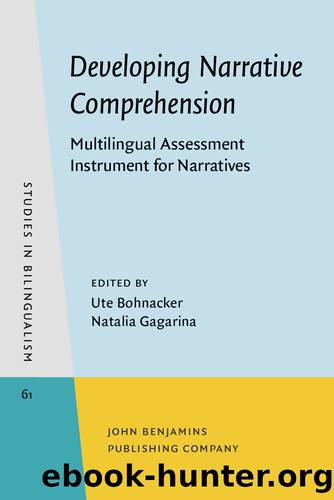Developing Narrative Comprehension by Bohnacker Ute;Gagarina Natalia; & Natalia Gagarina

Author:Bohnacker, Ute;Gagarina, Natalia; & Natalia Gagarina [Bohnacker, Ute & Gagarina, Natalia]
Language: eng
Format: epub
Publisher: John Benjamins Publishing Company
Published: 2020-11-26T12:18:10+00:00
1.1Assessing narrative skills
Narrative competence includes skills in both narrative production and narrative comprehension. Assessment of both skill sets can provide insights into a wide range of linguistic abilities as well as cognitive and pragmatic skills. Asking children to produce a brief sample narration provides rich data on story structure, structural complexity, internal state language, cohesion, morpho-syntax, and lexical diversity and productivity (Bohnacker, 2016).
Two distinct but interrelated areas underlie competence in narrative discourse: macrostructure and microstructure (Justice et al., 2006). Macrostructure concerns the higher-order mental organization of narratives, where content is connected through a global organization structure following an underlying narrative schema. Microstructure, which is much more language-specific, concerns the linguistic forms used in the narrative discourse (Gagarina, Klop, Tsimpli, & Walters, 2016; Iluz-Cohen & Walters, 2012; Simon-Cereijido & GutieÌrrez-Clellen, 2009). Most studies of childrenâsâ narrative skills have analyzed production but not comprehension.
Narrative comprehension is usually measured by asking children to answer questions about a narrative that was read aloud to them or shown to them as a series of pictures. The questions target information explicitly narrated in the story as well as information that must be inferred, such as charactersâ motives and mental states. Narrative comprehension tasks therefore address both linguistic and cognitive abilities.
The understanding of picture stories is verbally mediated, and the comprehension of a story read aloud involves similar processes as comprehension of a story presented in pictures (Bishop & Adams, 1992). During narrative comprehension, a child attempts to construct a meaning-based representation of the narrative through a number of processes at the word, sentence, and text levels (Oakhill & Cain, 2007; Perfetti, Landi, & Oakhill, 2005), making it a very complex task. At the word and sentence levels, children build linguistic information about the narrative and store it in verbal working memory. As the child follows the story, he/she transforms the pictures into a verbal representation of their contents (Bishop & Adams, 1992). Words and their meanings are integrated into the complex meaning of sentences. Individual meanings of sentences are then put together into a more global representation of the story content (Cain, Oakhill, & Bryant, 2004; Cain & Oakhill, 2009). At the same time, the child deploys so-called âhigher-levelâ cognitive processes such as inference-making in order to identify characters and their motives, follow the story structure and understand explicit and implicit information in the story, by integrating information contained in the story with previous world knowledge (e.g. Florit et al., 2014; Kintsch, 1994; Oakhill & Cain, 2007; Silva & Cain, 2015; van den Broek, Kendeou, Kremer, Lynch, Butler, White, & Purgzles Lorch, 2005).
Download
This site does not store any files on its server. We only index and link to content provided by other sites. Please contact the content providers to delete copyright contents if any and email us, we'll remove relevant links or contents immediately.
Cecilia; Or, Memoirs of an Heiress — Volume 1 by Fanny Burney(32198)
Cecilia; Or, Memoirs of an Heiress — Volume 3 by Fanny Burney(31587)
Cecilia; Or, Memoirs of an Heiress — Volume 2 by Fanny Burney(31548)
The Lost Art of Listening by Michael P. Nichols(7282)
Asking the Right Questions: A Guide to Critical Thinking by M. Neil Browne & Stuart M. Keeley(5489)
We Need to Talk by Celeste Headlee(5448)
On Writing A Memoir of the Craft by Stephen King(4745)
Dialogue by Robert McKee(4217)
Pre-Suasion: A Revolutionary Way to Influence and Persuade by Robert Cialdini(4036)
I Have Something to Say: Mastering the Art of Public Speaking in an Age of Disconnection by John Bowe(3794)
Elements of Style 2017 by Richard De A'Morelli(3257)
The Book of Human Emotions by Tiffany Watt Smith(3170)
Fluent Forever: How to Learn Any Language Fast and Never Forget It by Gabriel Wyner(2947)
Name Book, The: Over 10,000 Names--Their Meanings, Origins, and Spiritual Significance by Astoria Dorothy(2883)
Good Humor, Bad Taste: A Sociology of the Joke by Kuipers Giselinde(2835)
Why I Write by George Orwell(2809)
The Grammaring Guide to English Grammar with Exercises by Péter Simon(2657)
The Art Of Deception by Kevin Mitnick(2639)
Ancient Worlds by Michael Scott(2540)
